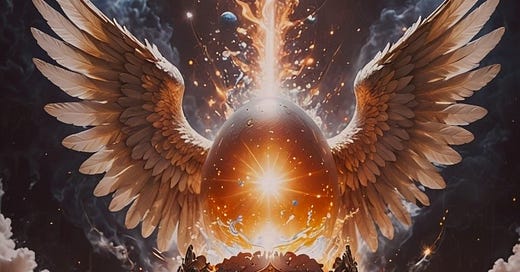Starry A.I. depiction of the HGA hatching from the egg.
Starry A.I. depiction of the HGA hatching from the egg.
The term “Holy Guardian Angel” is widely attributed to the Book of Abramelin, though it was already recognized in the Catholic tradition. Catholicism, along with Solomonic, goetic, and qabalistic influences, provided the cultural and spiritual foundation for the Abramelin text. The concept of a personal guardian angel has deep roots in the Church, with scriptural references (e.g., Matthew 18:10, Acts 12:13-15) suggesting a long-standing belief in these protectors even before the formal Church developed.
Saint Basil formalized this idea in the 4th century, writing that “beside each believer stands an angel protector and shepherd leading him to life” (Adversus Eunomium III, Catechism of the Catholic Church 1.2.1.1.5.1 #336). The Catholic Church actively encourages believers to seek guidance and support from their guardian angels, which is reflected in traditions such as medallions, litanies, candles, and novenas dedicated to these divine figures. In Orthodoxy, the guardian angels function similarly when one becomes baptized in the church.
The purpose of the Holy Guardian Angel, however, differs between the Abramelin and Saint Basil. The Abramelin emphasizes protection and guidance, stating that “every learned and prudent man may fall if he be not defended and guided by the angel of the Lord, who…led me undeserving from the mire of darkness unto the light of the truth.” It continues, urging readers to pray for the angel’s aid so that “ye fall not into sin through inadvertence, through ignorance, or through human frailty.”
Additionally, Abramelin describes the Holy Guardian Angel as a source of divine knowledge and magical wisdom: “my holy angel…not only manifested unto me the Veritable Magic but even made easier for me the means of obtaining it.”
S.L. MacGregor Mathers, in his introduction to the text, notes that “obtaining knowledge of and conversation with one’s guardian angel” allows one to “use the evil spirits for our servants in all material matters.” In other words, anything to do with the Abramelin is ultimately tainted by black magic. Speaking of black magic, Aleister Crowley’s Liber Samekh, states that the blue-skinned Smurfs are symbolic of the HGA!
“Thou art Ia-Besz: Thou art Ia-Aphophrasz.” These are variant names of the Egyptian gods Besz and Apophis. Besz was a common household deity, represented as a small blue dwarf. With regard to the relationship of this symbolism to the Angel, Crowley writes: “But the ‘Small Person’ of Hindu mysticism, the Dwarf insane yet crafty of many legends in many lands, is also this same ‘Holy Ghost’, or Silent Self of a man, or his Holy Guardian Angel. He is almost the ‘Unconscious’ of Freud, unknown, unaccountable, the silent Spirit, blowing ‘whither it listeth, but thou canst not tell whence it cometh or whither it goeth’. [John 3:8] It commands with absolute authority when it appears at all, despite conscious reason and judgment.”
Keep reading with a 7-day free trial
Subscribe to The Megas Aeon to keep reading this post and get 7 days of free access to the full post archives.






